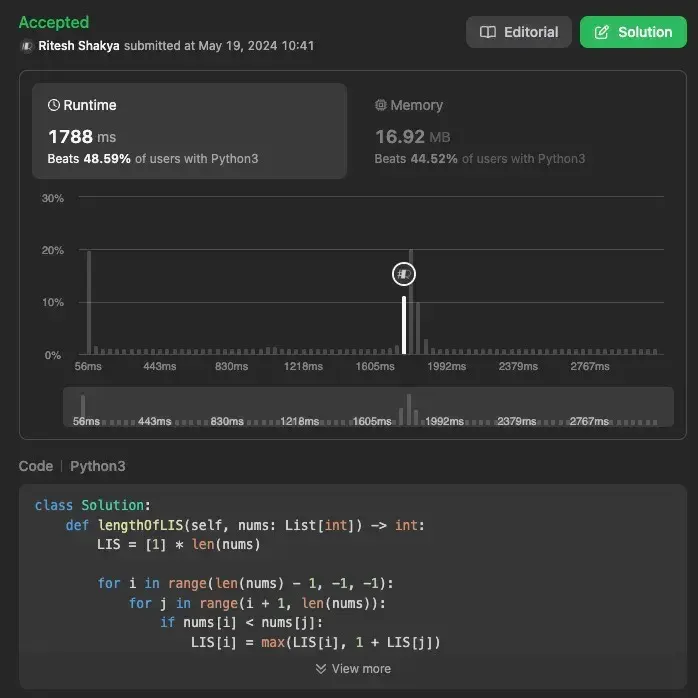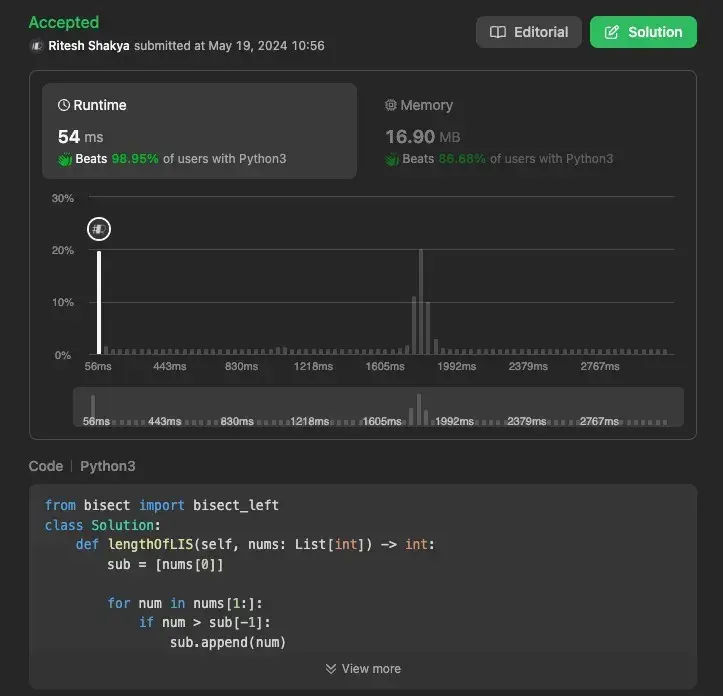Welcome to another journey into the world of algorithmic problem-solving! Today, we’ll tackle the problem of finding the Longest Increasing Subsequence (LIS) in a given array. This classic problem has multiple approaches, from brute force to highly efficient algorithms. Let’s dive in!

If you’re just joining us, it might be helpful to catch up on the previous entries. Want to see more problem-solving techniques? Follow me here on my blog!


Understanding the Problem
Given an integer array nums, our goal is to return the length of the longest strictly increasing subsequence. A subsequence is derived by deleting some or no elements without changing the order of the remaining elements.
Example 1:
Input: nums = [10,9,2,5,3,7,101,18]
Output: 4
Explanation: The longest increasing subsequence is [2,3,7,101], therefore the length is 4.
Example 2:
Input: nums = [0,1,0,3,2,3]
Output: 4
Example 3:
Input: nums = [7,7,7,7,7,7,7]
Output: 1
Using Efficient Approach: Dynamic Programming with Caching
Dynamic Programming (DP) is a method for solving complex problems by breaking them down into simpler subproblems. Here, we use a DP array to store the length of the LIS ending at each index. We then iterate through the array to update this DP array based on the conditions given.
def lengthOfLIS(nums: List[int]) -> int:
LIS = [1] * len(nums)
for i in range(len(nums) - 1, -1, -1):
for j in range(i + 1, len(nums)):
if nums[i] < nums[j]:
LIS[i] = max(LIS[i], 1 + LIS[j])
return max(LIS)
Explanation
- Initialization: We initialize a list
LISof the same length asnumswith all elements set to1. Each elementLIS[i]represents the length of the longest increasing subsequence ending at indexi. - Iterate Backwards: We iterate over the array from the end to the beginning.
- Nested Loop: For each
i, we check alljindices greater thani. Ifnums[i] < nums[j], it meansnums[j]can be appended to the subsequence ending ati. - Update LIS: We update
LIS[i]with the maximum value between its current value and1 + LIS[j]. - Result: Finally, the length of the longest increasing subsequence is the maximum value in the
LISarray.
Time Complexity: O(n^2), where n is the length of the input array. This is due to the nested loops.
Space Complexity: O(n), where n is the length of the input array. This is for storing the LIS array.

Using Efficient Approach 2: Binary Search with Greedy
This approach combines Binary Search with a Greedy algorithm. The idea is to maintain a list that represents the smallest possible tail of all increasing subsequences of various lengths. We use binary search to determine the position of elements and update the list efficiently.
from bisect import bisect_left
class Solution:
def lengthOfLIS(self, nums: List[int]) -> int:
sub = [nums[0]]
for num in nums[1:]:
if num > sub[-1]:
sub.append(num)
else:
i = bisect_left(sub, num)
sub[i] = num
return len(sub)
Explanation
- Initialization: We start by initializing a list
subwith the first element ofnums. This list will store the smallest possible tail values for increasing subsequences of various lengths. - Iterate Over Array: We iterate over the array starting from the second element.
- Comparison: If the current element
numis greater than the last element insub, we append it tosub. - Binary Search: If
numis not greater, we usebisect_leftto find the first element insubthat is not smaller thannumand replace that element withnum. This ensures thatsubremains sorted and maintains the smallest possible tail values. - Result: The length of the
sublist represents the length of the longest increasing subsequence.
Time Complexity: O(nlogn), where n is the length of the input array. This is due to the binary search operation within the loop.
Space Complexity: 𝑂(n), where n is the length of the input array. This is for storing the sub list.

How bisect_left Works
The bisect_left function from Python’s bisect module is a powerful tool for binary search. It helps find the insertion point for a given element in a sorted list while maintaining the list’s order. Specifically, it returns the position where the element should be inserted to keep the list sorted, favoring the leftmost possible position in case of duplicates.
Let’s break down how bisect_left works using an example.
import bisect
# Initializing list
li = [1, 3, 4, 4, 4, 6, 7]
# Using bisect_left() to find index to insert new element
# Returns 2 (leftmost possible index)
print("Leftmost index to insert, so list remains sorted is: ", end="")
print(bisect.bisect_left(li, 4))
Output:
Leftmost index to insert, so list remains sorted is: 2
Binary Search Mechanism
bisect_left performs a binary search on the list to determine the appropriate insertion point. Here’s how it works step-by-step:
- Initial Range: The search range is initially the entire list, with
lowat index0andhighat index6(the length of the list minus one). - First Check: It calculates the midpoint:
mid = (0 + 6) // 2 = 3li[mid] = 4- Since li[mid] is equal to 4, it updates
hightomid, making the new search range from index0to3.
- Second Check: It recalculates the midpoint:
mid = (0 + 3) // 2 = 1li[mid] = 3- Since
li[mid]is less than4, it updateslowtomid + 1, making the new search range from index2to3.
- Third Check: It recalculates the midpoint:
mid = (2 + 3) // 2 = 2li[mid] = 4- Since
li[mid]is equal to4, it updateshightomid, making the new search range from index2to2.
At this point, low is equal to high, both pointing to index 2. This is the leftmost index where 4 can be inserted to keep the list sorted.
Conclusion
We’ve explored the problem of finding the Longest Increasing Subsequence using two efficient approaches: Dynamic Programming with caching and a combination of Binary Search with a Greedy algorithm.
Each approach has its trade-offs in terms of time and space complexity, and choosing the right approach depends on the constraints of the problem and the size of the input.
Found this helpful? Follow me for more leetcode adventures! Questions? React out via email.
